 |
 |
 |
| |
Natural controllers of HIV infection are susceptible to immune perturbations similar to those associated with normal aging - implications
for women aging with HIV infection
|
| |
| |
Reported by Jules Levin
Presented at IAS 2011 - Rome, Italy
S. Desai1, E. Golub2, R. Greenblatt3, P. Norris4,5, J. Zhang2, K. Anastos6, H. Minkoff7, M. Young8, M. Nowicki9, M. Cohen10,11, S. Gange2, A. Landay1
email: seema_n_desai@rush.edu
1Rush University Medical Center, Departments of Immunology/Microbiology, Chicago, United States, 2Johns Hopkins Bloomberg School of Public
Health, Department of Epidemiology, Baltimore, United States, 3University of California , San Francisco, Departments of Clinical Pharmacy,
Medicine, and Epidemiology, San Francisco, United States, 4Blood Systems Research Institute, San Francisco, United States, 5University of
California , San Francisco, Departments of Laboratory Medicine, Medicine, San Francisco, United States, 6Montefiore Medical Center, Division of
General Internal Medicine, Department of Medicine, Bronx, United States, 7Maimonides Medical Center, Department of Obstetrics and Gynecology,
Brooklyn, United States, 8Georgetown University Medical Center, Division of Infectious Diseases, Washington, United States, 9University of
Southern California Norris Hospital, Department of Medicine, Division of Hematology, Los Angeles, United States, 10Rush University Medical,
Department of Medicine, Chicago, United States, 11The Core Centre at JH Stroger Hospital, Cook County
AUTHOR CONCLUSION
Immune activation and immune senescence occurs despite viral control in Elite controllers, and can contribute to accelerated aging among HIV-infected women
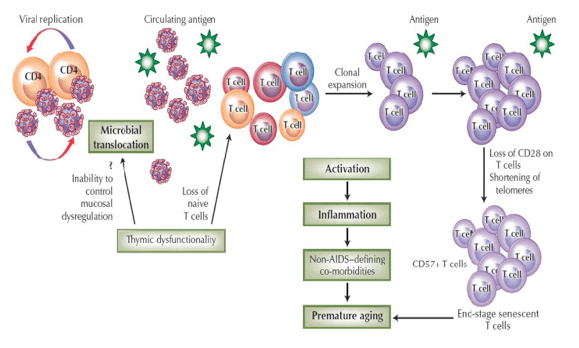
AUTHOR SUMMARY
ELITES controllers had significantly higher CD8 T-cell activation compared to HAART suppressed HIV infected (p=0.01) and HIV-negative (p=0.002) women suggesting that CD4 decline over period of time via activation induced cell death could have negative
inflammatory consequences in these group of natural HIV controllers.
ELITES controllers had significantly higher levels of CD8 T-cell senescence than HIV-negative women (p=0.03). ELITES had significantly lower levels of Naïve CD4 T cells compared to HAART-suppressed women (p=0.02) and higher accumulation of CD4 and
CD8 Terminal effectors (p=0.01,p=0.01 resp.) compared to HIV-negative women; a phenotype similar to that observed in aging subjects.
Expression of markers of activation, exhaustion and senescence on CD4 T-cells was less pronounced compared to CD8 T-cells. Significant low frequency of T-regs in Elite controllers
compared to HIV negatives were observed, suggesting lack of regulation; this might explain higher activation and senescence compared to HIV negative women. No significant differences were observed in Intracellular Cytokines levels in response to PMA+Ionomycin.
Activated T cells undergo repeated cycles of division resulting in terminal differentiated effectors cells which are senescent. Loss of CD4 naïve T-cells have been shown to correlate with higher microbial load in the periphery in a thymectomized mouse model8, thus contributing to lack of mucosal control which is already impaired in an HIV infected. Measurements for markers of microbial translocation are under investigation in these subjects and study.
Introduction
Advances in Anti-retroviral (ARV) therapy have resulted in longevity of life of HIV infected individuals. Chronic immune activation and inflammation persist despite viral control and are known to be associated with co-morbidities that mimic aging 1,2
Natural ("ELITE") controllers (<1% of HIV-infected individuals) maintain HIV RNA to <80 copies/mL for a period of 12-18 months in the absence of antiretroviral therapy 3,4
Elite controllers are enriched for protective class I allele (B5701), suggesting that CD8 T cell responses may play an important role in control of HIV replication.5
The presence of co-morbidities in HAART-suppressed individuals, and higher activation and microbial translocation in ELITE controllers, suggests negative consequence over time despite viral control6.7.
Recent findings that ELITE controllers have declining CD4 counts over time8 lead us to investigate immune responses in ELITES in a case-control study nested within the Womens Interagency HIV Study (WIHS).
We hypothesized that persistent immune activation contributes to immune senescence in ELITE controllers as compared to HIV-uninfected women. We present interim analysis of our ongoing ARRA funded biomarker study.
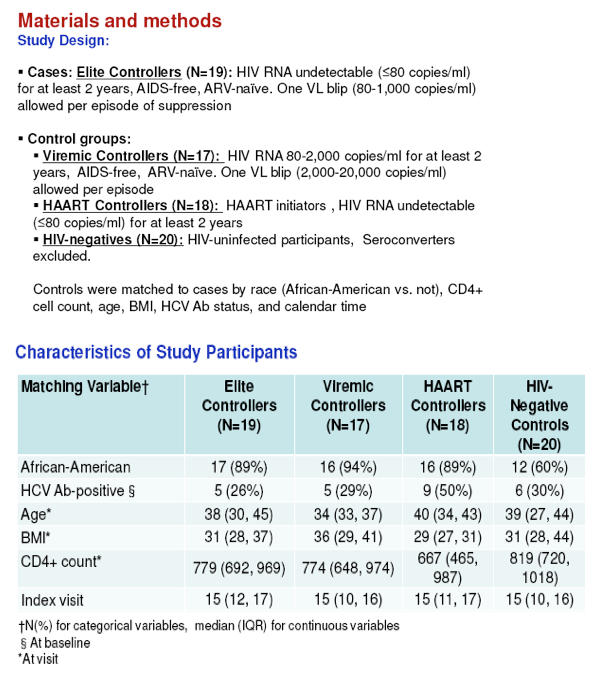
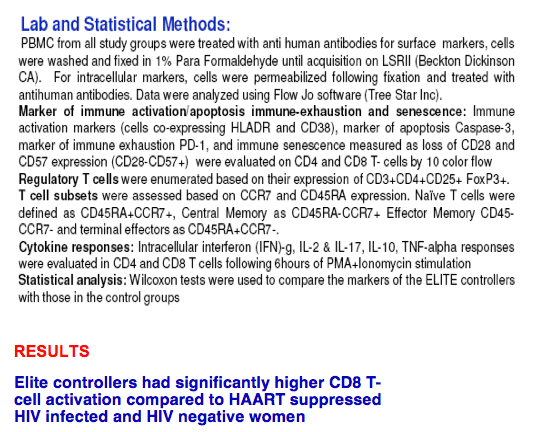
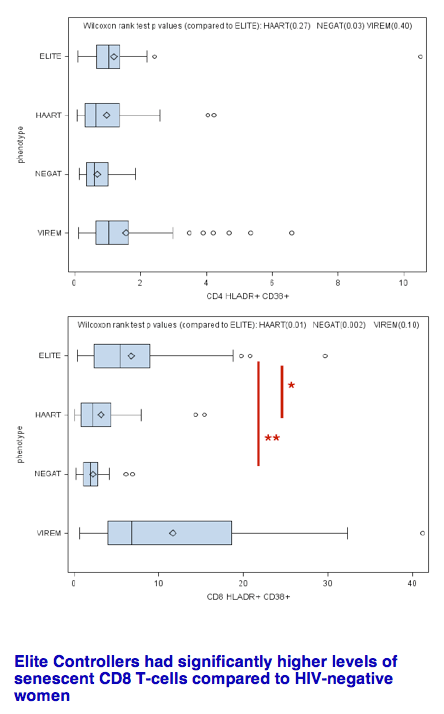
RESULTS
Elite controllers had significantly higher CD8 T-cell activation compared to HAART suppressed HIV infected and HIV negative women
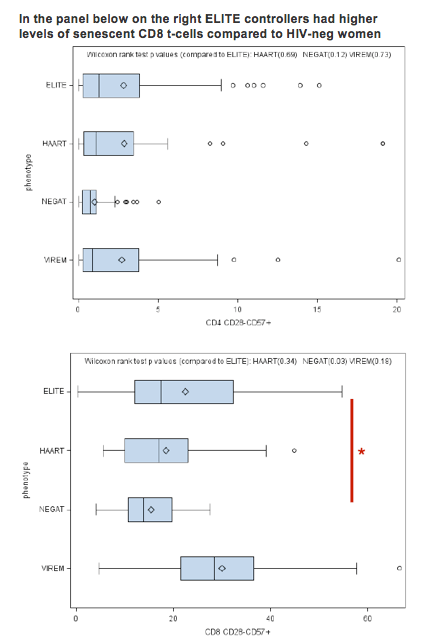
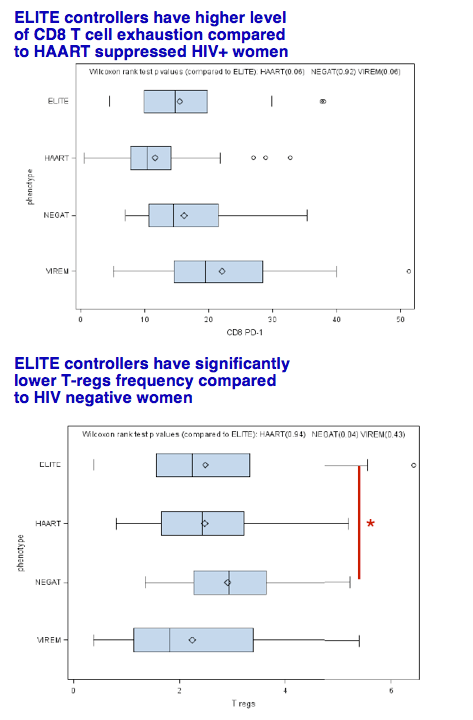
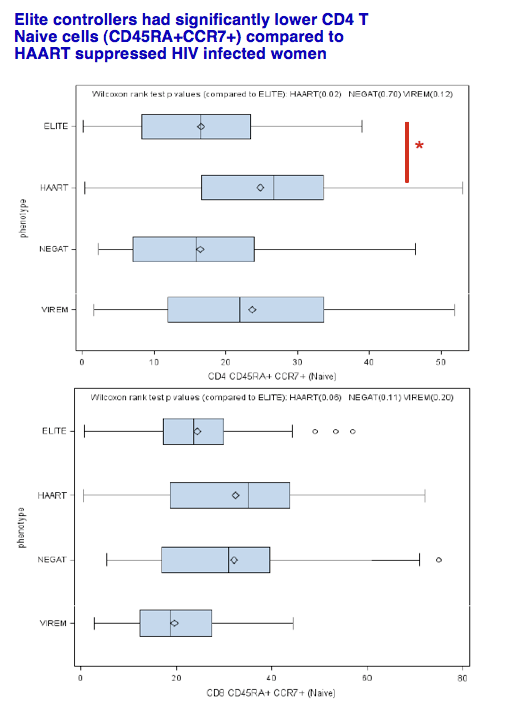
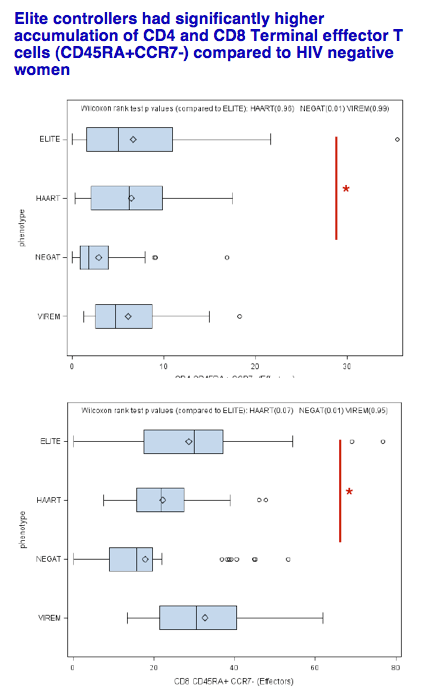
References
1.Desai S, Landay A. Early immune senescence in HIV disease. Curr HIV/AIDS Rep. 2010 Feb;7(1):4-10.
2. Desai, S et al #381, 16th Conference on Retroviruses and Opportunistic Infections, Montreal, 2009,
3. Saag M, Deeks SG. How do HIV elite controllers do what they do? Clin Infect Dis, 2010 Jul 15;51(2):239-41
4.Kaplan RC, Sinclair E, Landay AL, et al. T cell activation and senescence predict subclinical carotid artery disease in HIV
infected women. J Infect Dis. Feb 15;203(4):452-463.
5 Miura T, et al J VIrol 83(6):2743-2755, 2009
6. Kuller LH, Tracy R, Belloso W, et al. Inflammatory and coagulation biomarkers and mortality in patients with HIV infection.
PLoS Med. Oct 21 2008;5(10):e203.
7.Peter W. Hunt, Jason Brenchley, Elizabeth Sinclair, et al JID 2008:197, 126-133
8.Bourgeois C, et al. Proc Natl Acad Sci U S A. 2008;105:8691-8696
|
| |
|
 |
 |
|
|